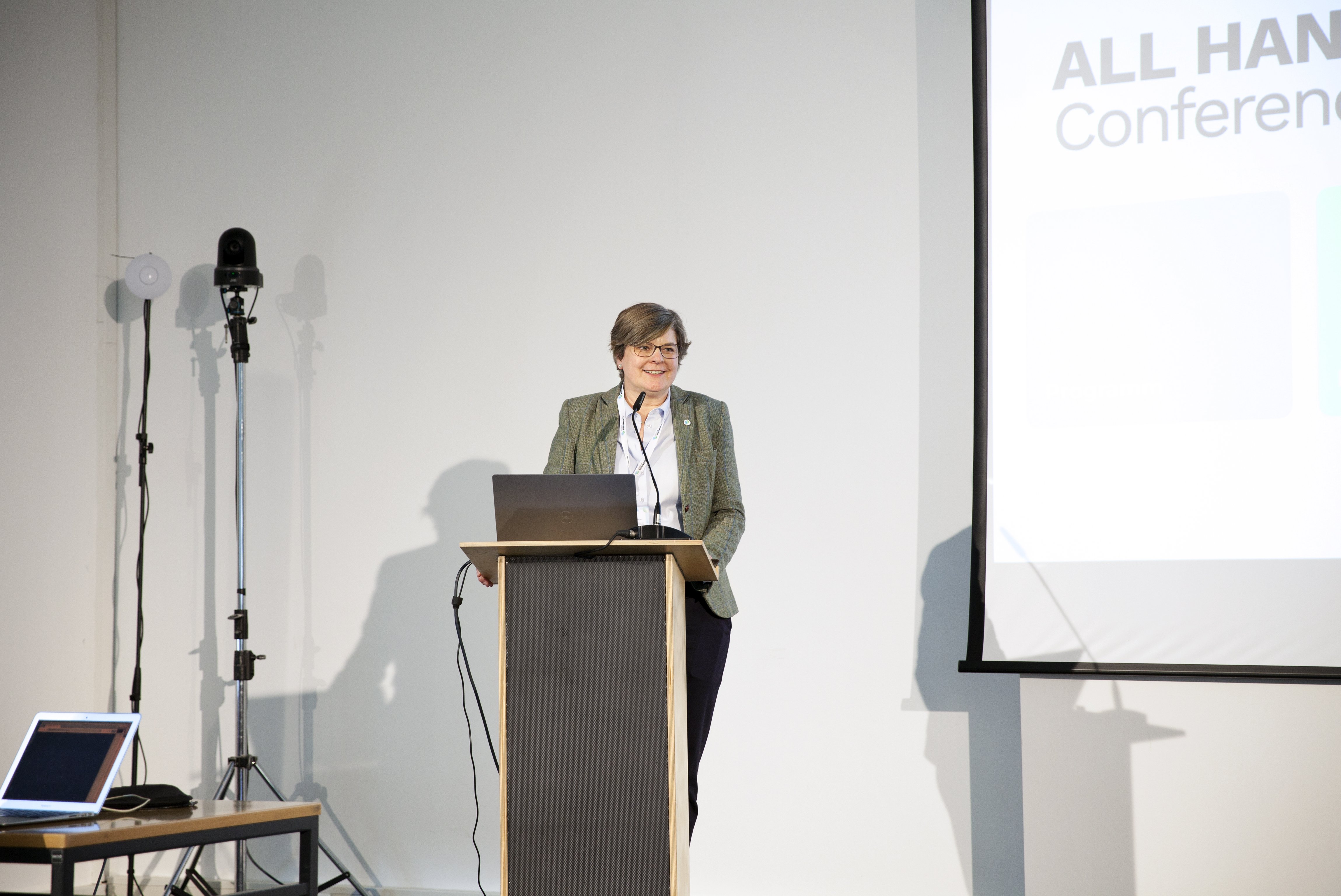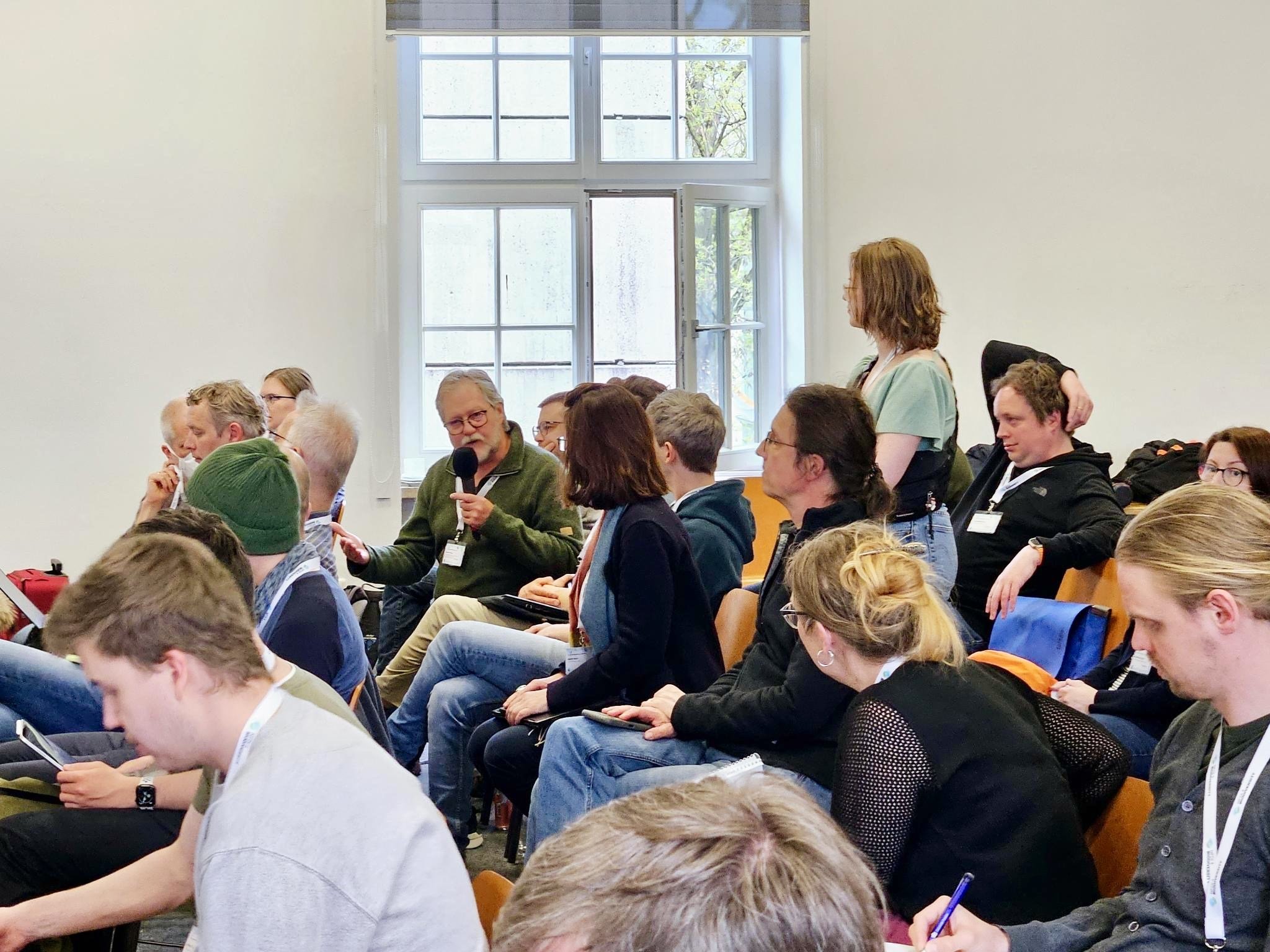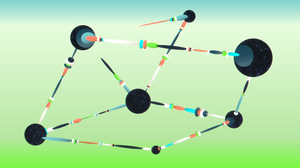Highlights of the All Hands Conference 2024

Largest German conference on biodiversity, ecology and environmental data
Taking stock after almost four years running time, recognizing the commitment of all those involved and looking ahead together to the second funding phase from 2025 – this is how NFDI4Biodiversity spokesperson Frank Oliver Glöckner outlined the goals of the All Hands Conference 2024 in advance. A plan that worked out: more than 120 project participants, cooperation partners and companions of the consortium came together in Munich from April 24 to 26 to summarize the work of the project in discussion formats and workshops and to move it forward together. Other interested parties took the opportunity to participate in the conference online.
The venue for what is certainly Germany's largest specialist conference on biodiversity, ecology and environmental data was the Directorate General of the Bavarian State Archives, one of the network's valued partner institutions. "We are delighted that we were able to host the All Hands Conference 2024 in Munich – not least because we are carrying out many exciting projects with the Bavarian State Archives," said Frank Oliver Glöckner on the choice of conference venue. For example, a start has been made on processing previously neglected data from the state archives for biodiversity research, including historical records on flora and fauna in Bavaria and central surveys on tree and plant populations. Furthermore, the collaboration in the NFDI4Biodiversity network has led to valuable cooperation with other partner institutions, such as the Bavarian State Natural History Collections (SNSB), with whom a pilot project for the digital long-term archiving of complex databases has been realized.

Biodiversity in the archive? Directorate General of the Bavarian State Archives (GDA) introduces representatives of state agencies to NFDI engagement
As this year's host of the conference, the GDA took the opportunity to invite representatives of Bavarian government agencies to a pre-event to explain the role of archives in the NFDI. The State Ministry of Food, Agriculture, Forestry and Tourism (StMELF), the Bavarian State Ministry of the Environment and Consumer Protection (StMUV), the Technology and Support Center at the Competence Center for Renewable Resources (TFZ), the Chair of Forest and Environmental Policy at the Technical University of Munich, the Bavarian State Natural Science Collections (SNSB), the State Office for the Environment (LfU), the Bavarian Species Conservation Center and Wildes Bayern e.V. accepted the invitation.
In his welcoming address, Dr. Bernhard Grau, Director General of the Bavarian State Archives, emphasized the comprehensive commitment of the Bavarian archives to the NFDI and their expertise in the preservation and indexing of analogue and digital data. Dr. Lina Hörl, head of the GDA team, which is involved in various areas within the NFDI, followed this up by explaining the participation in various consortia such as NFDI4Memory, NFDI4Objects, Base4NFDI and, more intensively, NFDI4Biodiversity, NFDI4Earth and FAIRagro.
Two projects were then examined in more detail: Tanja Weibulat from the SNSB presented a project for the long-term archiving of digital data in relational databases. The SNSB have developed the DiversityWorkbench for this purpose - a software for describing and annotating digital data with freely selectable taxonomies. As part of a pilot project with the GDA, the database of powdery mildew fungi from the Munich herbarium was archived in SIARD format, which was developed by the Swiss Federal Archives. Together with the GDA, the submission structure for the Archival Information Package (AIP) and the metadata in the Archive Subject Information System of the Bavarian State Archives (AFIS) were defined. Following successful transfer to the Digital Archive of the Bavarian State Archives, further SNSB holdings can follow, such as fossil fish and mite mouthparts.
Another example concerned GDA's collaboration with Prof. Malte Rehbein from the University of Passau and Thore Engel from iDiv, Halle-Jena-Leipzig, as well as students. They digitized and analyzed a survey from 1845 in which 114 forestry offices reported 43 animal species. The tables, which were digitized and transcribed with AI support, resulted in around 5000 data records on animal occurrences. These are fed into the GFBio e.V. data hub and can then be accessed via the 'Living Atlas of Nature in Germany' (LAND) portal developed as part of NFDI4Biodiversity.

The contributions and the lively discussion that followed impressively illustrated how valuable biodiversity data from analog archives can be made digitally accessible – and how important it is to continue the joint work.
State of Bavaria as a "reliable partner in the NFDI"
The official start of the conference was marked by a welcome address from the project management. Frank-Oliver Glöckner (University of Bremen/MARUM/Alfred Wegener Institute for Polar and Marine Research), spokesperson for NFDI4Biodiversity, emphasized the clear focus of this year's conference: the joint preparation of the second funding phase from autumn 2025.
Director General Dr. Bernhard Grau joined the event with a welcoming address, highlighting the great potential of archives and the data stored in them for research. The Bavarian state archives alone hold more than 50 million archival records, many of which are relevant for biodiversity research, including historical records on species occurrence, climate, forestry and agriculture. Furthermore, the archives could contribute their great expertise in the long-term archiving of data to the NFDI - which, as mentioned, is already being implemented with great success in several consortia.
Ministerial Director Dr. Rolf-Dieter Jungk from the Bavarian State Ministry of Science and the Arts also addressed the conference participants: He emphasized how important the digitization of valuable information stored in archives is – and that sustainable data management is undoubtedly the basic prerequisite for this. The state of Bavaria wants to be a "reliable partner for the NFDI" and, as a GDA, wants to contribute to long-term archiving, especially in the areas of metadata management and interface design.

Relevance of better data management using the example of wild bee monitoring
Dr. Petra Dieker from the Johann Heinrich von Thünen Institute in Braunschweig then offered exciting technical insights. In her presentation "Monitoring and understanding biodiversity change with the power of many", she used the example of wild bees to illustrate how important continuous monitoring programs are for understanding biodiversity change. One challenge, however, was the diversity and complexity of the data collected, which often made archiving and evaluation a challenge. Dieker also emphasized once again the urgency of high-quality, reliable and combinable data for biodiversity conservation - and at the same time emphasized how essential the joint commitment of scientists and authorities is for this.
Successes of the first funding phase: showcase for mobilized "data treasures", extensive networking activities, service portfolio and more
The subsequent reports from the task areas formed a kaleidoscope of the diverse activities that have been jointly implemented by the consortium's 50 partner institutions – including research institutions, museums and archives, natural history societies and data centers as well as environmental agencies and authorities – since the start of the project.
The Living Atlas of Nature in Germany (Task Area 1, Community Engagement), for example, should be highlighted here, which clearly presents the "data treasures" of natural history associations that are mobilized as part of NFDI4Biodiversity. Users can access a wide range of data on the distribution and diversity of species in Germany via the platform; at the same time, the data providers benefit from the fact that their data becomes more visible - for example in the scientific community, for which the data from the specialist societies is of great interest. In the second funding phase of the consortium, the platform will be further expanded and will also increasingly include data on flora and fauna from citizen science projects.
Other highlights were the national and international networking that was intensively promoted in funding phase 1, which was identified from the outset as a prerequisite for the success of NFDI4Biodiversity. Both technical and organizational cooperation with other data infrastructures in Germany and abroad therefore forms the core of the activities of Task Area 2, which initially concentrated on identifying the most important stakeholders together with the Special Interest Group Strategy and based on the existing activities of the consortium members. These include, among many others, the Global Biodiversity Information Facility (GBIF), which aims to collect biodiversity data worldwide and make it freely accessible, and above all promotes global cooperation and the open exchange of information on biodiversity. Other important cooperation partners identified include the Federal Agency for Nature Conservation (BfN) as the central federal scientific authority for national and international nature conservation, which plays a key role in the provision and coordination of nature conservation data in Germany, and the European Open Science Cloud (EOSC), a Europe-wide initiative that promotes an open and trustworthy environment for the management of scientific data, with a particular focus on open access to research data and interoperability between different data infrastructures.
These networking measures are diverse and range from concrete implementation steps and the organization of events under the umbrella of the respective infrastructure to the formulation of memorandums of understanding. Cooperation has already been intensified with eight of the ten prioritized infrastructures. The two remaining stakeholders will be addressed in funding phase two.

Further milestones were presented by Task Area 3, which is concerned with compiling a range of applications and tools - provided by the consortium's partners – that meet the diverse interests of biodiversity research and nature conservation. Over the past three years, a comprehensive service portfolio has been developed. 80 services from 23 partner institutions have been cataloged to consolidate tools and technologies.
Other successes include the establishment of the helpdesk, where experts from the NFDI4Biodiversity network are available to answer questions relating to the management of biodiversity data and which is based on the close cooperation of several partners, and the development of a strategy for quality management.
Task Area 4 presented its progress in the development of the Research Data Commons (RDC), which is intended to form the central infrastructure within the NFDI to facilitate the exchange of research data and services. NFDI4Biodiversity is driving the conceptual and technical work of the RDC centrally and aims, among other things, to create the conditions for integrating data and metadata from different providers. In addition, the consortium is committed to establishing a distributed storage infrastructure in order to guarantee that the resources provided via the RDC are available in the long term. Current and future work includes the connection of further pilot projects, the use of AI technologies, the implementation of FAIR Data Products and increased networking with other NFDI consortia.
The organizational framework for the consortium's work is Task Area 5, which is responsible for the central coordination, collaborative governance and sustainability of the jointly established infrastructure and which was rated very positively in the interim report evaluation by the German Research Foundation (DFG). Key tasks here include the administration of where-used lists, reporting obligations, budget planning, cross-consortium and external communication and the organization of events. Goals for the second funding phase include a stronger distribution of funds into the community in order to support ideas from the network and to maintain the positive development of the project in order to achieve the desired goals.

Poster Session, Tools Marketplace and Workshops
The poster session then offered the opportunity to find out more about how the work presented by the task areas is being carried out in detail: More than 40 individuals and working groups took part and were available to answer questions and discuss their posters. For the first time, visitors to the conference were also able to vote for what they considered to be the most successful poster. The winners of the vote were:
- 1st place Robert Köpke: The Story in the Data – Presentation of the Storytelling Format Map Stories to Convey the Stories behind the Data Sets in an Appealing Way
- 2nd place Giada Matheisen, Lina Hörl, Thore Engel und Malte Rehbein: Mobilization of Historical Animal Observation Data – the Bavarian Survey of 1845
- 3rd place Thore Engel, Martin Friedrichs-Manthey, Robert Köpke, Jörg Holetschek, Aletta Bonn, Birgitta König-Ries and Anton Güntsch: Living Atlas of Germany's Nature – a platform developed in NFDI4Biodiversity for discovering species in one's own environment
Many more posters from the conference can be found in the NFDI4Biodiversity Zenodo Community.
Another highlight was the Tools Marketplace, where participants were able to get to know and try out (further) developed applications for working with biodiversity data in NFDI4Biodiversity – including the image annotation program BIIGLE, the Living Atlas of Germany's Nature and the data management system BEXIS2.

The workshop sessions also met with great interest. Topics included training datasets and teaching materials for research data management, the onboarding of RDC services, networking with national and international initiatives, the standardization of data from a user perspective, the further development of the service catalog, the involvement of the biodiversity data community in the work of the consortium, the development status and future of the Research Data Commons and the community project bioschemas.org, which is committed to improving the discoverability and usability of bioscientific resources.
The conference's varied program was complemented by sufficiently long breaks and free-space slots, which gave participants the opportunity to network, further develop ideas developed in the sessions – or discover the host's exciting data: In various small-group tours, interested parties were able to attend guided tours of the Bavarian Main State Archives, led in an educational and entertaining way by staff from the Directorate General.
Once again, the All Hands Conference has shown how valuable it is to continue the work that usually takes place largely remotely about once a year with combined forces in one (beautiful) place. We would like to thank all participants for the great contributions, the important comments, the good discussions and the new inspiration!
As the All Hands Conference is largely an internal working meeting, not all of the content mentioned in this report has been published in a readable form. If you would like more detailed information on certain topics, please contact us using our contact form.

























